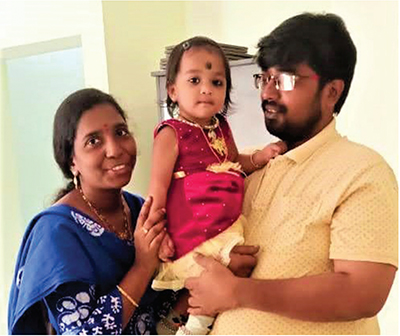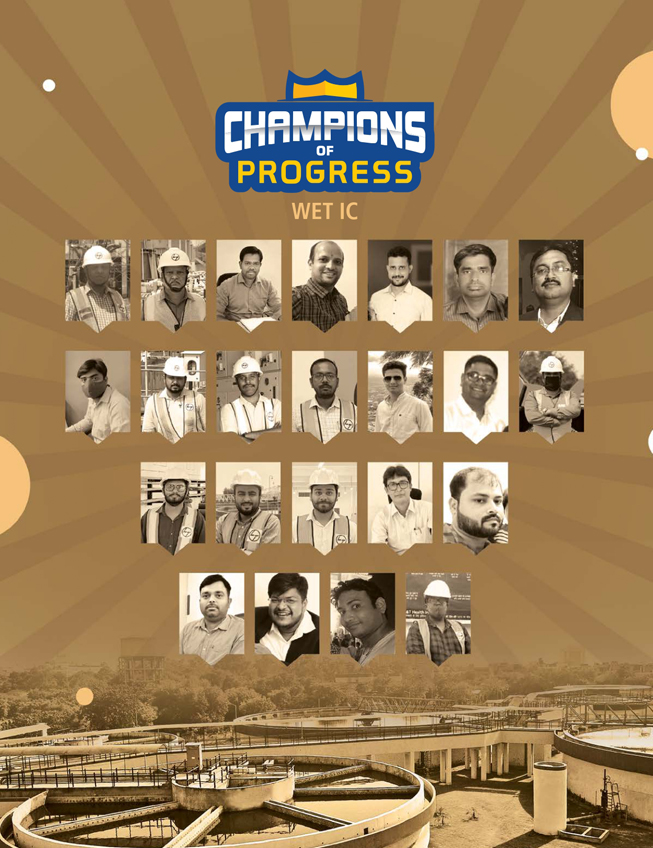
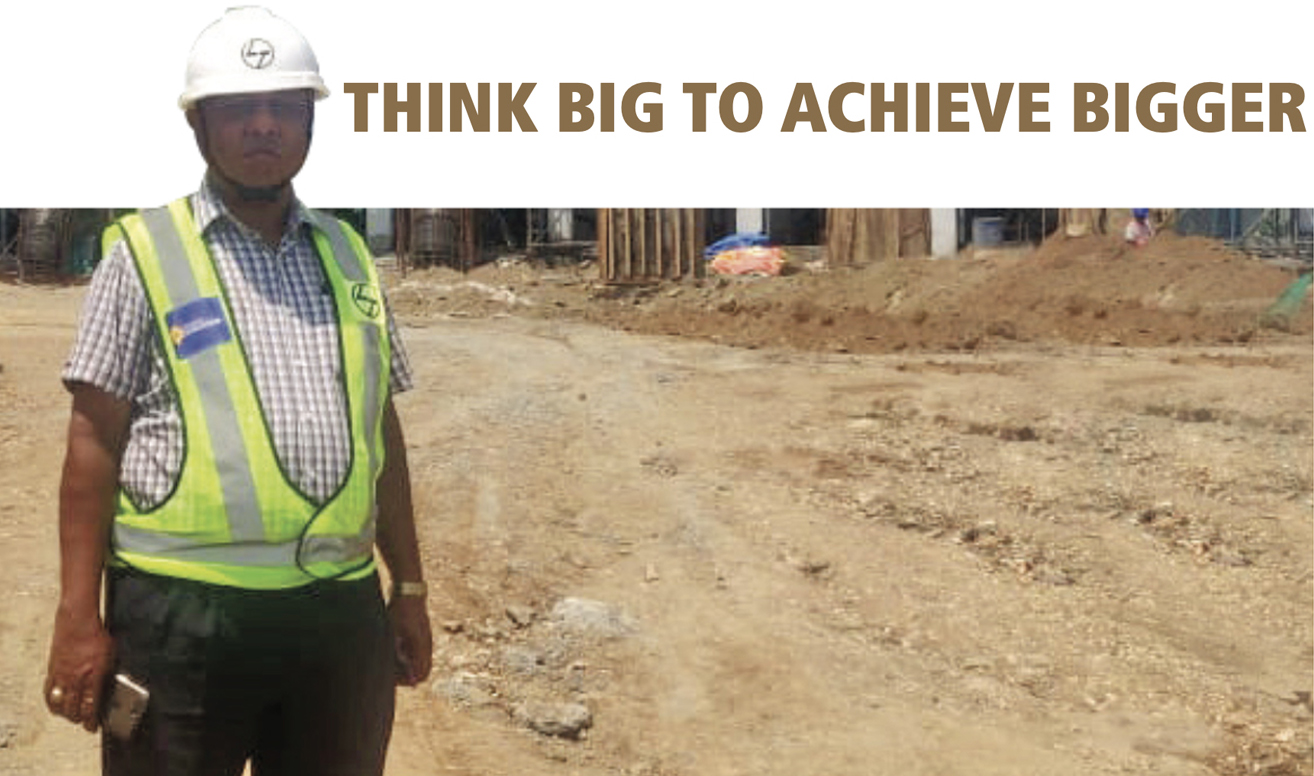
T. Venkateswaran
Senior DGM (Civil), WET IC
Success depends on several factors but as T. Venkateswaran, Senior DGM (Civil) at the Athikadavu LWS II site advocates, it is equally vital to develop and nurture one’s ability to think big. “L&T was a big break for me, and it got bigger with the onus of realizing a 50- year dream project for the people of the districts of Coimbatore, Tirupur and Erode with surplus water from the Bhavani Sagar dam lifted through pumping stations to an elevation of 270 m to recharge the PWD tanks and village ponds accounting for 1040 nos. and amounting to 1.5 tmc of water recharge per year.”
For Venkateswaran and his team, it was a mixed work approach that won them the day. “We implemented a secure back-to-work strategy for each district as per the collector’s directives,” he inforAfter successfully sourcing the first batch of 200 workmen by air, they gradually upped the numbers as more fronts opened. “We hit the ground running, focusing on the immediate milestones such as completing the sump rafts for pump houses by sharing the resources and scaling up operations for tasks that were similar in nature.” Having completed three of the total six pump houses in the project, they were able to fast track work aware of the criticalities involved.

We hit the ground running, focusing on the immediate milestones such as completing the sump rafts for pump houses by sharing the resources and scaling up operations for tasks that were similar in nature.
The success of a project of this complexity requires all around contribution and Venkateswaran acknowledges the excellent support from their client. “Our welfare measures for the workmen like providing separate vehicles for workmen commute, establishing isolation wards, conducting regular medical check-ups and providing amenities at the camp received a huge boost with the client facilitating the bureaucratic formalities.”
Settling down at site is something that Venkateswaran does not recall much, “It happened so fast and with cooperative colleagues and seniors around, I felt at home, something which is unique to the L&T culture.” With Dindigul, his hometown, hardly a three-hour drive from site, Venkateswaran gets to connect with the family that includes his wife Selvapriya, a homemaker and daughters, Dhanushree, who is pursuing 2nd year MBBS and Vishaalini who is in class VIII. For this on-field professional, it is the family spotlight that matters, “My wedding was a memorable moment and recently when my daughter got the MBBS seat through merit it was a proud feeling for all of us.”
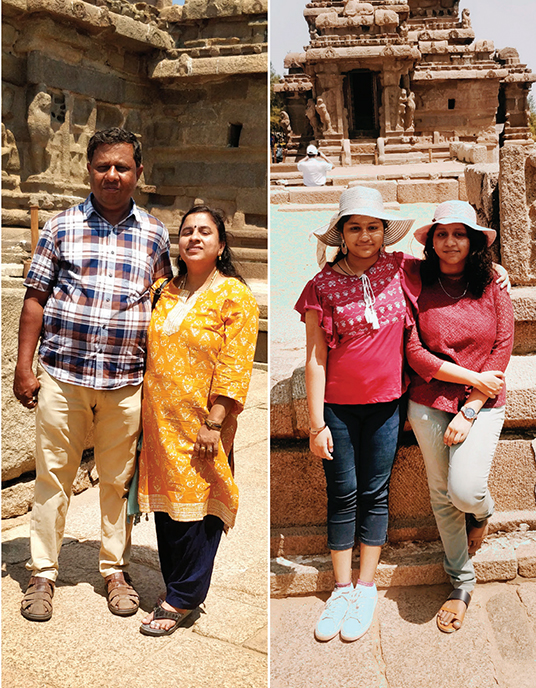
ALWAYS UP TO HIS BEST
N. Ashok
DGM (Mechanical), WET IC

Having been associated with L&T for 35 plus years, N. Ashok, DGM (Mechanical) at the Athikadavu LWS II site has evolved into a specialist in mechanical works especially pipeline assembling and laying, always committed to put his best foot forward that has held him in great stead. “I believe that by doing the best at this moment, you are better placed for the next and that’s how we have gone about achieving our various deliverables,” he shares.
“With back-to-back contractors scarcely available, we broke down the processes, sourcing manpower only from agencies while tools/tackles and P&M was provided by L&T which worked well especially during the initial days after work resumed,” Ashok reveals. With pipeline laying at the core of the project, Ashok and team soon realized that a single strategy could not work across as their alignment ran across highways, canals, water ways, rocky terrains and under HT/LT lines. “We pursued with the concerned highway and power departments to get permissions and deployed line agencies while in some cases, we connected with the villagers to explain the importance of the scheme. For the canal areas, we followed up with the irrigation department to close the water flow to carry out our pipelaying works.”
Monitoring was partly digital and partly physical considering the span and as Ashok explains that all the six stretches had individual in-charges along with frontline engineers and divided such that each engineer controlled only 4 km to ensure focus. “For real time progress, we relied on digital platforms,” he infor“From the client’s side there was overwhelming support to clear the ROU, facilitate remote inspections wherever possible with most of our interfaces through MS Teams.”
Although each team member gained insights on redefining strategies, “the biggest learning,” says Ashok, “was to be prepared for the worst and now, we are in a position to realign any facet of the project and still achieve the overall objective, all thanks to the collective efforts aided with some smart digital tools.”
Ashok muses that once completed, this project would be another landmark in his long list of achievements. “From joining as a DET in 1986, completing my graduation from BITS Pilani in 2010, to receiving my 30-year long service award, the quest to learn and grow in L&T continues to be my aspiration.” Hailing from Thanjavur, Ashok credits his wife Parimala who is a postgraduate in Hindi and Tamil for nurturing their son, Adithyaa who is in class X.
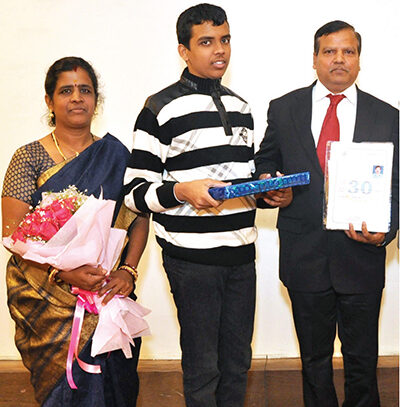
TALENT WINS GAMES, BUT TEAMWORK AND INTELLIGENCE WINS CHAMPIONSHIPS
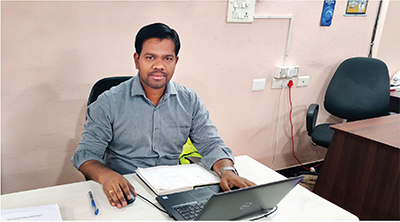
L. Balaji
Planning Manager, WET IC
Having been in the business of planning and Management Information Systems (MIS) for close to a decade now, L. Balaji, Planning Manager, at the Athikadavu- Avinashi Scheme, appreciates the importance of teamwork. “We might have grand plans but executing the scheme well is the most vital part of the process and the invaluable lesson that keeps ringing in my ears, is espoused by the greatest sporting talent, the legendary Michael Jordan, that ‘Talent wins games, but teamwork and intelligence wins championships.’ This is what has kept us in good stead during these challenging times.”
As of now, the team has achieved significant progress across fronts, and they all deserve a pat on the back for overcoming all their challenges. “As a planning professional, I have always relied on robust MIS to steer schedules, but the pandemic was a different ball game. We had to think out of the box, bring in all our experience and adopt different approaches to work to achieve our deliverables.” The learnings are now a part of our execution memory, he chuckles. “We are now better prepared to handle the worst.”

We had to think out of the box, bring in all our experience and adopt different approaches to work to achieve our deliverables. We are now better prepared to handle the worst.

On a reflective note, Balaji shares the many facets of planning that are key to overall execution, “No one can whistle a symphony. It takes a whole orchestra to perfom it and here it was my team comprising Abhishek, Rajam Joga Rao, Chandali and Giridhar, who shared the responsibility. It was like having 5 planning managers on a mission to accelerate progress.”
Away from his project, Balaji has had his limelight moments, “Taking my parents by flight for the first time from Chennai to Delhi was an awesome feeling, as was receiving the best employee citation during my GET days that has kept the fire burning in me and of course completing an executive MBA after an academic gap of 8 years.”
IN SYNC WITH PLANNING AND EXECUTION
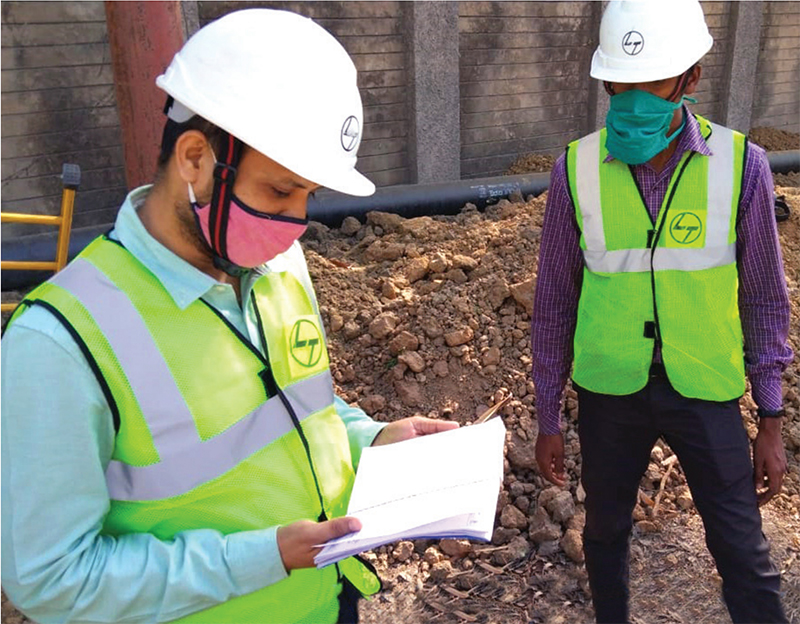
Avinash Dwivedi
Construction Manager (Civil), WET IC
With more than 200 villages around Rajasthan’s Banswara Pratapgarh region, accessing potable water well before the lockdown, the job was half done for Avinash Dwivedi, Construction Manager (Civil). “It is a huge project with three zones covering around 334 villages and the fact that we had already moved into the defect liability period meant that we were on track.”
Zone 1 with 140 villages were the first beneficiaries. “We arranged passes for our operators to ensure uninterrupted supply of water during the restricted period,” he shares. “It was huge boon for the locals as earlier they had to trudge long distances to fetch water. In a way, we helped the administrators to restrict the movement of people,” quips Avinash.

We stuck to the fundamentals, targeting specific areas, clusters, which were critical and later closed in on the other fronts. While the pipeline was the lifeline of this project, there were other key structures that called for specialised execution methods.
Having steered the execution of works in Zone 1 for over 4 years from 2013 to 2016, Avinash skilfully handled the various on-ground challenges. When the pandemic situation developed, he was given the onus to oversee the planning for Zones II & III. “We stuck to the fundamentals, targeting specific areas, clusters, which were critical and later closed in on the other fronts,” informs Avinash. “While the pipeline was the lifeline of this project, there were other key structures such as the intake well, approach channel, raw water reservoir and water treatment plants that called for specialised execution methods.” Overall, we accelerated safely wherever possible, he indicates, “keeping in mind that the construction, testing and commissioning of civil structures and pipeline works complement the final delivery.”
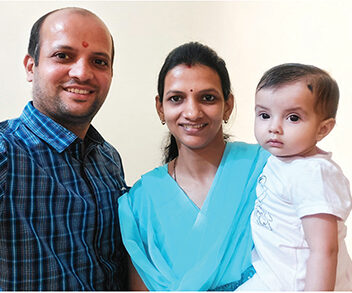
Like all on-field L&T professionals, Avinash sings praises of the digital initiatives. “Our in-house solutions helped enhance quality and safety while ensuring that we bridge the gap in areas where distance was an issue. Most of our digital applications have drawn the attention of the client and today, it is the preferred mode for connecting, inspecting, and even securing approvals.”
Avinash’s family includes his wife Nidhi who is a homemaker and daughter Anaya, who are based in Sagar, his hometown in Madhya Pradesh. Unwinding after a day’s work means listening to some good old Hindi melodies for which Avinash makes time for and agrees that, “they rejuvenate you to face another challenging day at work.”

The final leg of any race is always most tense especially if one has not built up a substantial lead which is what Sandeep Ratnoo was feeling at his Baswara-Pratapgarh WSS project. “Fortunately, we had done the hard work much before the lockdown and when it came to deliverables, it was largely about powering the network which was well within our control.”
While giving finishing touches, Sandeep and team had another responsibility as Zone I was already commissioned and providing water to around 140 villages, “Ensuring water supply at this end of the project was a separate mission by itself as we could not afford the risk of failure even for a single day especially during the lockdown, being a vital service.” A composite project, the distribution framework has been designed with sustainable features. “All the Elevated Storage Reservoirs (ESR) are powered by solar panels and it was our responsibility to keep them running to assess the status of water distribution that depended on some key ground factors,” informs Sandeep. “The solar panels powered the flow of water into the ESRs, and it was important to monitor their functioning across 64 remote locations that is being done consistently and successfully, due to our collective team effort.”

L&T’s work culture encourages employees to continuously improve the quality of their work and recognises contributions towards enhancing the quality of construction to create value for stakeholders. We are responsible corporate brand ambassadors and play an active role in the community towards the betterment of everyone.
The last phase of the project relates to what Sandeep likes doing and is good at. “Electrical and instrumentation works are nearing completion across the 13 pump houses with key installations such as the vertical pumps completed, a new switch yard feeding 33 kV power over a stretch of 7 km and the SCADA system integrated at the two WTPS.”
Having been with L&T since 2014, Sandeep has high regard for its learning and developmental opportunities. “L&T’s work culture encourages employees to continuously improve the quality of their work and recognises contribution towards enhancing the quality of construction to create value for stakeholders.” Overall, he sums up, “We are responsible corporate brand ambassadors and play an active role in the community towards the betterment of everyone.”
Sharing the success moments of the project with his wife Bhagyashree, a home maker, is something that Sandeep cherishes. “Back home at Kuchaman in Rajasthan, I used to get some time to play my guitar and ukulele but then the joy of successfully commissioning a project and seeing people’s lives transformed is always memorable.”


From the time Rajkumar Kondappan joined L&T, he has been involved in developing water lifelines across projects. “I must have engineered, integrated and laid close to 2000 km of pipelines, which gives me a deep sense of satisfaction.” Continuously improving the process is his real motivation for as he says, “there is so much to learn as each project is unique and the key is doing it right the first time as water infrastructure projects have a vast span.”

I must have engineered, integrated and laid close to 2000 km of pipelines, which gives me a deep sense of satisfaction.
Rajkumar began to create his mechanical footprint with the HUDA Recycled Water Supply Project in 2017. “Initially, laying 110 km of pipes seemed to be a tough job but with larger projects came greater responsibilities as my subsequent assignments at Bagidora-Banswara-Pratapgarh covered a network of more than 300 villages.”
In his present Banswara project, the challenge for Rajkumar and his team has been to lay 2419 km of pipeline with a large section of the alignment running through the Aravalli hills across hard rock. “This called for secure and deep trenching methods involving rock breaking aligning to the highest standards of safety,” he points out. “It was a laborious process, and we could not afford the risk of any gaps considering the sensitivity of working in the hills.” Working hard and smart kept them ahead in the game. “We came up with many process enhancement methods depending on the criticality of the works especially when executing structures such as the approach channel, raw water reservoir, intake well, approach channel and timed the delivery synchronizing the civil and mechanical works.”
The good work has reaped rewards for Rajkumar and team. “We moved into the defect liability period by early June 2020 and with most of the pipeline network tasks across zones II & III in line, this should be a grand finish despite the tough situation.”
Getting back home does take some days, admits Rajkumar as his family including his wife, a home maker, and two children, daughter, Ramya Jyothi, aged 6, and son, Satheesh, aged 3, are based near Madurai in Tamil Nadu. “I’m eagerly looking forward to return home once we close in on the immediate milestones.”
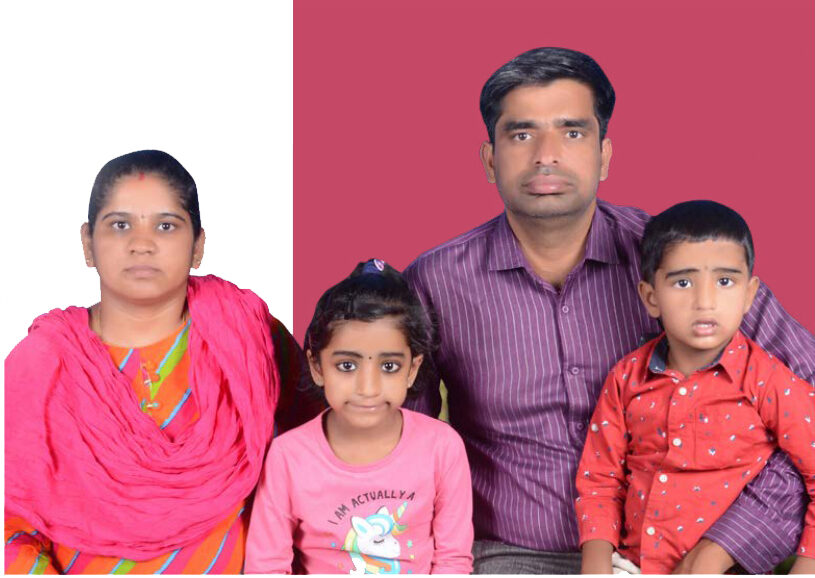
FINDING THE RIGHT BALANCE
Tamal Saha
Construction Manager, WET IC
Preparing for a day ahead especially during these tough times is not easy but all of us rely on our own unique ways of finding balance. Some, like Tamal Saha, Construction Manager, Barrackpore Integrated Sewerage System project, has an interesting way. “Usually, I begin my day early, spending time with my colourful love birds, attending to them, taking inspiration from their exuberant spirit and chirping. It gives me the perfect head start for a gruelling day at site,” he assures with a broad smile.
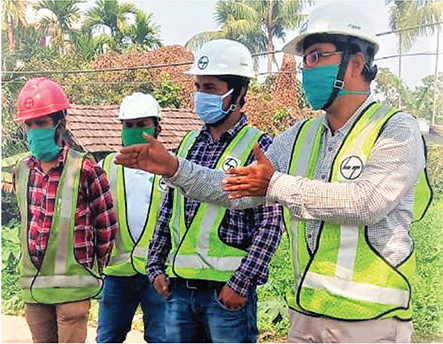
Once at the work front, it is like finding one’s way through a maze, remarks Tamal, “Ours is a typical city job with the alignment running through congested areas that is full of utilities and with the pandemic, came a newer set of challenges that included following the restrictions to ensure the well-being of the workmen while closing in on the milestones.” Tamal agrees that technology tools have cleared the ground to a large extent. “We deployed GPR survey and the utility detector to identify underground utilities while the risky trenching works were fast tracked safely with horizontal drilling machines and trenchless pipe laying methods.”

Ours is a typical city job with the alignment running through congested areas that is full of utilities and with the pandemic, came a newer set of challenges that included following the restrictions to ensure the well-being of the workmen while closing in on the milestones.
For other significant structures like the STPs, the team relied on Lean Management techniques to maximize efficiencies and productivity. “We focused on works that were within closed boundaries where public movement was restricted and turned the pandemic situation into opportunity by engaging more machinery at lower costs, organized factory acceptance tests for the client and engaged our limited manpower for the most critical tasks.”
“For some time, till we bridged the gaps, night shifts became a regular and with a young team holding fort, we achieved decent progress with the client endorsing our digital approach for inspections,” mentions Tamal. “We went a step ahead and arranged video conferences with our vendors and subcontractors to make them understand the importance of aligning to the SOPs which was critical for our way forward post resumption.”
Back home, it is a different role for Tamal as he becomes a teacher for his daughter Ritisha and her friends, “I spend around two hours teaching them while my wife Sananda, joyfully oversees our interactions,” shares the delighted father.

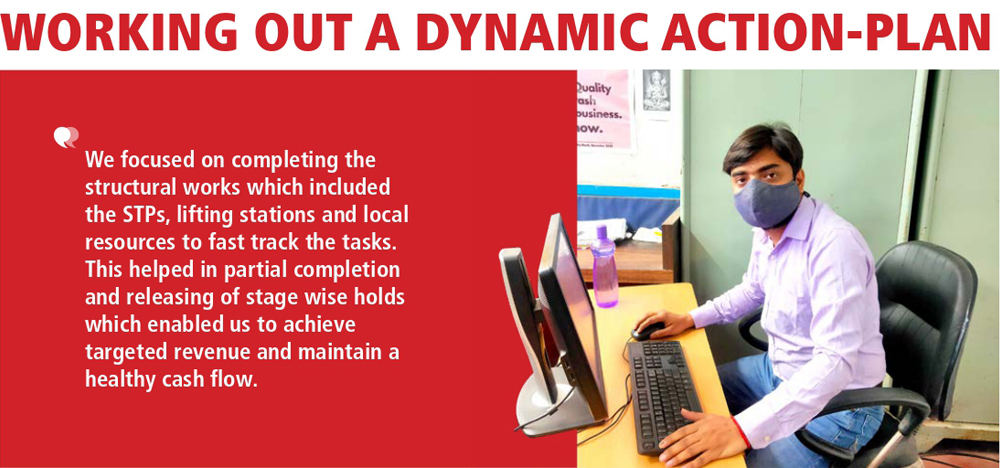
Swarup Sikder
Assistant Construction Manager (Civil), WET IC
One of the first things that Swarup Sikder, Assistant Construction Manager (Civil), took up when operations resumed at his Barrackpore Sewerage Project was to address tasks within closed boundaries. “We focused on completing the structural works which included the STPs, lifting stations and local resources to fast track the tasks. This helped in partial completion and releasing of stage wise holds which enabled us to achieve targeted revenue and maintain a healthy cash flow.”
He recognizes that having a young and energetic team was a huge advantage, “always ready to accept challenges and raise the bar when it mattered most.” Aiming to play safe and get it right the first time, Swarup says, “Initially, we continued with regular night shifts as the approach was secure considering the restrictions in place and gradually scaled up momentum. Targets were scrutinized from a financial perspective and priorities were lined up, taking cognisance of the internal and external dynamics.” Planning, he agrees, was dynamic and discussed at all interactions. “Young minds see things from a very different perspective, and they steered the course of action with the guidance from senior members,” he observes. “In a way, it helped everyone to have a comprehensive view of the overall milestones apart from their individual targets.”
Theirs is a typical city job with the network running through congested areas surrounded by utilities, some of them as old as the city itself, sighs Swarup. “We made inroads with state-of-the art technology like horizontal drilling machines and trenchless pipe laying methods that fast tracked works across critical sections.” Digital tools have made the entire process transparent with the client endorsing our all-out efforts. “Monitoring, inspecting and approving on a real-time mode have made our job easier,” he smiles, nodding that good work always forges bonds of trust. “Our client seeing our efforts chipped in to facilitate the formalities with regard to approvals and work permits.”
“The larger goal of building a vital water infrastructure keeps me busy while my wife, Ipsita Jana, who is a MD in Homeopathy, keenly pursues her duty of keeping people healthy back home at my village in Munsirhat,” highlights Swarup. “For the time being, I balance between Japanese animation, web-comics and a little bit of gardening at site.”
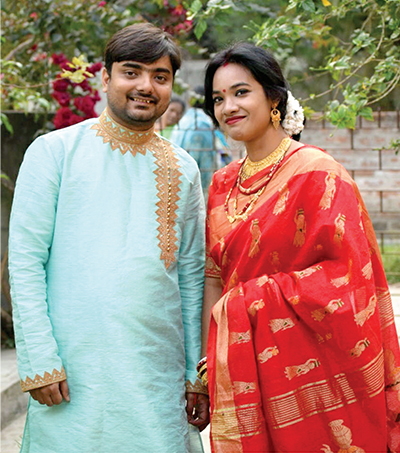
‘FOCUSED TACTIC’ MAKES THE DIFFERENCE

Prateek Singh Rathore
Construction Manager, (Civil), WET IC
“By now, we all have some idea on how to thrive in a crisis by being prepared for the worst,” declares Prateek Singh Rathore at the Infrastructure Works at Bidkin. “Over the last few months, we have addressed multiple challenges as we resumed work, some of which were unthought of. We have stood together as a team and delivered some very significant achievements. Overall, it has been a tense but satisfying turnaround.”
A special job, the Infrastructure works at Bidkin has a scope that is more than a typical WET IC project. “We have a line of core civil works including laying roads, constructing drains, culverts, bridges and of course the WET portion covers water supply, sewerage treatment and even the power infrastructure setup.” With TI IC entrusted with a major part of the scope, the job also calls for a lot of interfaces especially when the fronts overlap.
For Prateek and his team. unlock meant that they had to have keys for several issues. “Labour management was at the top as we were left with only minimum strength. Of course, there were local resources but training and raising their skillsets within a short span of time was a huge ask. Instead of going all out, we concentrated on pragmatic acceleration of the on-going activities through consistent project management.” Nothing fancy, it was a common-sense and logical approach, mentions Prateek that helped them do things right the first time, avoid rework and keep moving forward.
“It was a whole new ball game with so many civil structures in scope,” remarks Prateek. “I had to plan the execution, stage by stage, streamline activities through effective communication across various stakeholders and arrive at the right strategy at the right time and place. Our ‘focused tactic’ worked well as we succeeded to optimise the available resources to complete the immediate targets while ensuring the safety of employees and workmen.”

Our ‘focused tactic’ worked well as we succeeded to optimise the available resources to complete the immediate targets while ensuring the safety of employees and workmen.
“When I began in L&T at the underground drainage works in Jamnagar, the 350 km of pipe laying works and 31 pumping stations seemed a major achievement but today, here we have achieved something much bigger,” says Prateek in awe. “Going forward, I’m sure there will be bigger projects, calling for bigger commitments to succeed.”
Hailing form Bhopal, Prateek and his wife Sweena Kabra, who is a homemaker, have a delightful bundle of joy, their toddler son, Avyukt, who keeps them busy at home.

INSPIRED BY L&T’S CREDO

Balaji Venkatesan
Assistant Construction Manager, (Electrical), WET IC
L&T’s credo of ‘We make things that make India proud,’ that sums up the company’s role of being nation builders is Balaji Venkatesan’s inspiration to join L&T. Presently at the Infrastructure Works projects at Bidkin, he says, “Today, I am proud that we are executing key infrastructure for one of India’s first industrial smart cities, jointly by WET and TI ICs, involving the construction of an electrical substation, power, and utilities, STP, CEPT, roads & highway structures.”
“Streamlining the resumption of works was the toughest part as most of the workmen had migrated to their hometowns while there was a long pending list of commissioning and integration activities with 8 substations in line for charging,” mentions Balaji. Rather than waiting for the perfect moment, he and his team got going with the available limited local resources, making vital course corrections on the way to keep progress on track.
Balaji realizes that achieving targets means a lot more than just completing works. “Maintaining cash flow and parallel certification of works are key factors to keep the project healthy and we were able to breathe easy by roping in the client through regular interactions over digital platforms to update the real-time status of works, resolve issues on ground and convince them for timely approvals.” He agrees that if not for digital tools, it would have been tough to close in on the milestones. “Pragati, BIM and MSP were some key digital tools that helped us identify the leads for acceleration, focus on the lag areas and realign schedules as per timelines.”

It is a collective effort, and, in our case, it was a mixed group with the seniors facilitating the youngsters with cross-domain learnings which helped us achieve our overall targets.
Into his second assignment in L&T, Balaji knows well that having the right person for the right task is half the job done. “It is a collective effort, and, in our case, it was a mixed group with the seniors facilitating the youngsters with cross-domain learnings which helped us achieve our overall targets.”
It is a long way from Bikdin to Chennai but Balaji is assured that his home is secure in his wife, Dillirani’s care, and that his two children, a daughter, and a son, are in safe hands. “We keep in touch daily through the digital platform and I look forward to a good break after commissioning our milestones.”
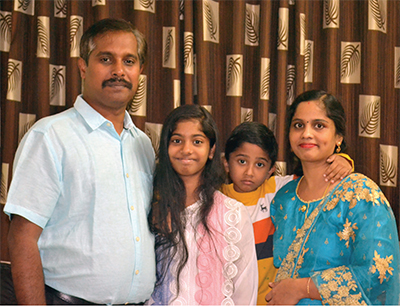


Rohit Kumar has been busy putting together some secure production plans to help make up for the lags to a large extent at the Infrastructure Works project in Bidkin. “When I joined there years ago, I was responsible to drive a section of the precast production. Today, the site management has entrusted me to oversee the production for the entire Package II.”
With most of the crew migrating to their hometowns, Rohit was left with a small team but there was a larger issue to be addressed. “After a long hiatus, the production equipment needed some overhauling and due to the pandemic situation, the service engineers were not able to visit our site. However, based on my earlier experience of handling such equipment, I serviced and put the line back into operation which was the first activity to progress.”

We had multiple brainstorming sessions to address issues, took up maximum number of parallel activities with additional shifts and finally with a great deal of effort achieved our targets.
Planning was a key factor and everyone’s onus at site, he highlights. “It was about achieving cross-domain milestones in this composite project. For the erection of segments, the team had to be doubly careful as any slip would have stymied progress. Sticking to the fundamentals, we developed a case specific milestone activity for every segment which was physically monitored and executed as per our safety and quality standards.” The manner of progress evolved as they moved forward. “We had multiple brainstorming sessions to address issues, took up maximum number of parallel activities with additional shifts and finally with a great deal of effort achieved our targets.”
One of the biggest gains according to Rohit is the confidence that the workmen have shown since resumption. “The feeling that you are in safe hands has to be felt during these times. We have gone the extra mile, ensured their well-being to earn their credibility. As we are in the last leg of the project, there are more willing hands to make this a grand finish.”
Like most L&T-ites, Rohit acknowledges the support of his wife, Beena Kumari Shrivastava, who is a homemaker, for taking care of their children, son Avyansh and daughter Anika. “It’s her presence at home that gives me the focus to concentrate at work.” Playing cricket was his passion but then “it is becoming increasing difficult, so I take pleasure in watching the game and following up with a bit of motivational reading to keep myself mentally relaxed.”


At Bidkin, where WET and TI ICs are executing a first-of-its-kind hi-tech industrial smart city project, work resumed with a flurry of activity and the team, including Tarique Zeyad Khan, Senior Engineer (Civil), prepared to face the several challenges with resilience and strength. “My transition from a GET to Senior Engineer (Civil) happened quickly and seamlessly and soon I hit the ground running, taking up tasks in addition to my scope and getting into every facet of project management. Overall, it has been a thoroughly enriching phase enabling me to step into the big league of project management with confidence.”

“All along I used to think that execution was the toughest part of the job but here I learnt that managing resources is key to achieving milestones,” shares Tarique. “When operations stalled due to the shortage of skilled labour.” At this juncture, the senior members decided to tap local resources to address the immediate milestones. For Tarique, it was a learning experience, getting an insight into the frame to see how to deftly overcome challenges. “We got going with some vital numbers, backed by aggressive skill-based training which ultimately helped to meet the immediate concerns.”
When it came to approvals, Tarique was the ‘go-to’ man for the site team, an extremely critical task as it ensured the availability of the right resources at the right place in time. “For which, I ensured timely approvals, regularised work orders, released purchase orders with continuous follow-ups for mobilization.” He closely coordinated with the front-line engineers to monitor progress, to get inputs and reports which helped the site management to identify and plug gaps.
Like all youngsters, Tarique is adept with digital platforms which he credits for fast tracking of works. He has been the mainstay at site to streamline the EIP 4.0 roll out. “This has helped to complete the system processes in time and made the utility very user friendly.”
For this youngster, there is a lot to look forward to but for now his thoughts are with his parents. “My most memorable moments are the times that I spend with my parents who are based in Raxaul in Bihar. As I had to move away from them at a very young age to purse my education and now my career, it is always a pleasure to meet them whenever I go home, and I cherish the memories and good times I share with them.”
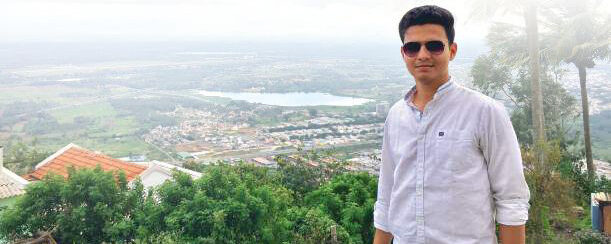
A DIFFERENT FIELD BUT THE ACTION CONTINUES
Rishabh Upadhyay
Project Administration and IR Manager
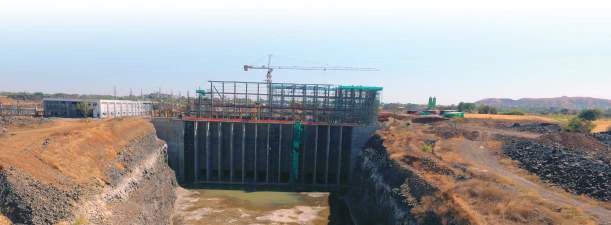
For Lieutenant Commander, Rishabh Upadhyay (Retd.), Indian Navy, action continues at L&T’s Kundalia Irrigation Project, Right Bank, where he has a larger role to play facilitating a range of administrative tasks. “This project had two distinct phases,” he briefs. “Initially, it was about arranging things for the workmen at the camps, providing health care facilities, conducting daily pep-talks and roping in the local administration whenever there was an issue. The latter part involved putting together a mobilisation strategy to provide access to work fronts across the entire alignment.”

In December 2002, I was in the state NCC Naval Wing and was working hard to get selected for the Republic Day camp and when I found my name in the final list, it was the happiest day in my life. Ultimately that helped me step into the Indian Navy.
With years of experience on the high seas, Rishabh, was mentally prepared for the tough battle ahead. “As a team, we were largely successfully about convincing the workmen that the best thing was to stay back while there were a few who wanted to return to their hometowns. Taking the District Collector’s support, we worked out a secure demobilisation plan that involved organising medical check-ups, arranging transit documentation and vehicles.”
When fronts opened, Rishabh and his team faced a new development. “The state government insisted on engaging local workmen which meant that we had to demobilise around 200 of our existing workmen, register the new recruits and go through a lot of formalities in line with the SOPs.” Later, when there was an additional need, they travelled to Rajgarh and even Jharkhand, to interact with the local administration and source resources directly.
Convincing the villagers was another challenge for the team. “There were rumours that people at our site were badly affected and that workmen gangs were a threat because of which roadblocks were organised by the villagers.” Rishabh and team had to take the support of sarpanches and civil authorities to address the issue. “We took up empty schools as quarantine centres, established a thorough screening process with medical camps which ultimately convinced the villagers. For some time as we resumed, our IR employees were at the wheels, ensuring the safe commute for the workmen.”

Hailing from Lucknow, Rishabh’s family includes his wife, Namrata, son, Naimish and his mother, Neelam. Sundays are always special for him as he indulges in his hobbies of reading novels, listening to music. Getting into the services is something he vividly recalls, “In December 2002, I was in the state NCC Naval Wing and was working hard to get selected for the Republic Day camp and when I found my name in the final list, it was the happiest day in my life. Ultimately that helped me step into the Indian Navy.”
AT THE HEART OF THE MATTER
Prashant Mani
Assistant Manager, (Mechanical), WET IC

A larger mission of providing irrigation facilities to around 16000 Ha area is what drove Prashant Mani, Assistant Manager, (Mechanical) and team, once operations resumed at Kundalia Right Bank Canal project. “A series of workmen motivation drives organized by the IR and EHS Departments set the ball rolling, resulting in the workmen numbers gradually increasing. Our immediate target was to complete the pipeline work in Zone 1 but then the task had many on-field challenges that had to be deftly mitigated.”
One imperative was for the team to directly interact with the villagers as most of the alignment ran through their farmlands. “Convincing them was perhaps the toughest part of this job due to the span of the network,” remarks Prashant. “In some places, it was easy to make the villagers understand the importance of this infrastructure but elsewhere, we had to work out a communication plan with the support of the local administrators, listing out the complete safety arrangements made in line with the SOPs.” While this key task had to be accomplished across more the 20 locations, Prashant had an internal issue to address. “The workmen were afraid to take up works despite our secure arrangements and so we deployed a special team whose main objective was to interact with every workman, make them understand that they were in safe hands by running through our safety procedures both at work and at camps.”
Whether it is a thermal power plant or a water infrastructure project, a pipeline network is always the heart of the matter, says Prashant. “In my earlier projects, outside L&T, at Reliance Jamnagar, Khandwa and Khargone Super Thermal Plants, the span was not so vast, but the criticality of the task was high. In this case, the challenge was to monitor the execution of works across the entire alignment. Thanks to our digital applications such as ViewEHS, MAPinr and Quality Apps, we connected virtually, tracked on-field progress for real-time updates while ATL & RAPL helped in self-development.”

Our good work has earned the villagers’ credibility and now we have many helping hands whenever there is an issue as they all know for sure that their lives will be transformed for the better when this project is commissioned.
Prashant’s interaction and networking with the locals has been to such an extent that today he can get things done on his own. “Our good work has earned the villagers’ credibility and now we have many helping hands whenever there is an issue as they all know for sure that their lives will be transformed for the better when this project is commissioned.”
While back at home in Gorakhpur with his wife Sonam, a home maker, and toddler son, Rudransh, Prashant, loves to give his wife a welcome break by taking up some cooking.

MAKING GROUND FOR MILESTONES
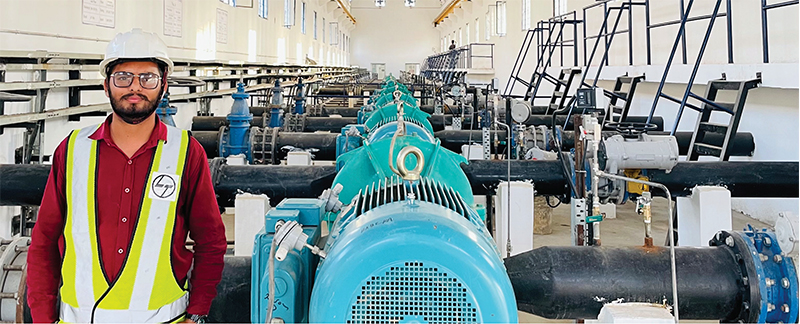
Khushpreet Singh
Senior Engineer (Civil), WET IC
For Khushpreet Singh, at the Moga WSS, stepping into the big league of project management happened so quickly that he credits his seniors and colleagues at site for enabling the smooth transition. “It was a big break for me and an important one too as I was involved in building a first-of-its-kind water infrastructure for Punjab, my home state.”
As a civil in-charge, there was a lot of ground to cover, indicates Khushpreet, “It is a huge plant spread across 4 acres and the key structures that had to be raised on an uneven terrain included a 50 MLD WTP, 1140 KL Raw Water Reservoir and Raw Water Pump House, 5400 KL CWR and two MBRs of 1140 KL capacity involving around 8000 cum of concreting.” Mid-way through, restrictions came in place, sighs Khushpreet and the focus was on workmen management. “This was one of my biggest learnings as I had never handled such a task before, but the situation called for it and each one of us at site took up the mantle to ensure the well-being of workmen, motivating them and ensuring that they were in safe hands.”

We targeted critical tasks such as the MBR works which involved a 25 m high staging support, lining up predefined workmen to accomplish the activity within a short period. Similarly, other milestone activities were scheduled and completed to compliment the overall project delivery.
Upon resumption, Khushpreet and team turned all their focus to hit the ground running but importantly in the right direction. “We targeted critical tasks such as the MBR works which involved a 25 m high staging support, lining up predefined workmen to accomplish the activity within a short period. Similarly, other milestone activities were scheduled and completed to compliment the overall project delivery.” From the client’s side, there was constant support in the form of facilitating approvals, interacting with the local community and bureaucracy to resolve on-ground issues, acknowledges Khushpreet.
For Khushpreet, the joy of having completed such a huge and challenging project is twofold: the kudos of the people from across 85 villages thankful for potable water is wonderful but having done so in Amritsar, the place where he was born and brought up gives him a special high. “My parents are proud of my contribution and share my achievements with my friends and relatives while I cherish the PRAISE award and hard work that enabled the inauguration of the plant by the Chief Minister of Punjab.”

DIGITALLY STEERING QUALITY
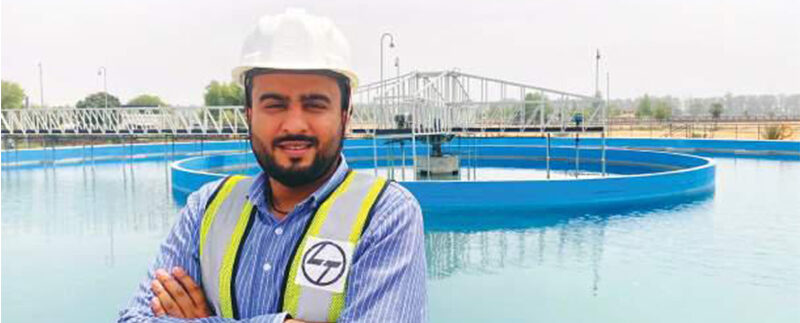
Sourabh Bhatt
Assistant Manager (Mech), QA&QC, WET IC
Sourabh Bhatt, performed the dual role of quality in-charge and digital champion at the Moga WSS. “In a way it was complementary as most of our work assessments were digitally driven making our job much easier,” he shares.
However, there were some unique challenges apart from the pandemic situation that had to be addressed smartly, highlights Sourabh. “As the quality of the surface water from the canals had deteriorated over the years, people were apprehensive about the quality of water despite the treatment facility.” At times like these, Sourabh admits, “your work should speak more than anything else and we did precisely that by inviting some of the prominent locals to our treatment plant to assess the entire process. We went even a step ahead, by taking and testing a portion of the treated water in our laboratory to remove any doubt about its quality.”
It was a big stage, admits Sourabh, sharing his apprehensions and fears especially during the initial stages of the project. “The stakes were high, and the pandemic added to the tension as I was worried about my toddler daughter at home. When some of my colleagues were affected at site, the challenge become bigger, calling for great amount of cross-functional tasks. All along, we stood together as team, backed one another and pushed hard to achieve the deliverables.” He mentions other forms of bonding, outside of work that worked well like virtual team lunches to keep up the morale.

The stakes were high, and the pandemic added to the tension. All along, we stood together as team, backed one another and pushed hard to achieve the deliverables.
The dual role has given Sourabh the much-needed edge and recognition too! “Tools such as e-monitoring, smart glasses, virtual inspections ensured that we were on track. All the good work culminated with the project bagging the quality trophy award and being recognized as the most digitally enabled site in the IC. Receiving the award from the senior management of WET IC was my milestone moment at L&T. Yet another memorable day was when my digital initiative, ‘Mymaps’, got listed as best innovative solution.”
For both Sourabh and his wife Ruby, their one and half year toddler daughter, Yashvi is their joy. “Most of my hobbies like reading, watching films have taken a backseat but when at home, it is Yashvi that keeps us on the move,” he sums up joyfully.
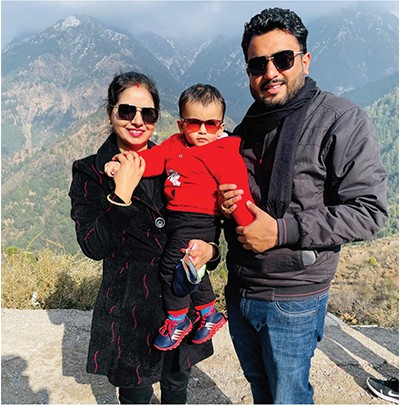

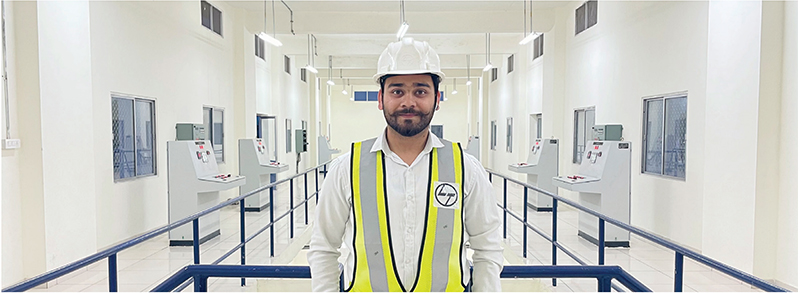
At the Moga WSS project, Himanshu has been making his presence felt by switching roles and taking up larger responsibilities. Currently holding fort as Planning In-charge, he has a lot to share of being part of WET IC’s latest benchmark. “After completing my Diploma in Civil Engineering, I was posted at Moga WSS project in 2017 as a Civil Execution Engineer and was involved in the construction of key structures like the Rapid Gravity Sand Filter House and the Wash Water Recovery Tank.” But there was much more in store, he says, his eyes gleaming. “With the planning In-charge moving out, I was asked to step up and be a part of the planning team.” A big task, he acknowledges, “but my seniors encouraged and guided me to take up the challenge, and today, this insight has enhanced my prowess.”

With the planning In-charge moving out, I was asked to step up and be a part of the planning team but my seniors encouraged and guided me to take up the challenge, and today, this insight has enhanced my prowess.
For Himanshu and team, their action-packed innings began when the lockdown commenced. “All our existing plans came to a standstill and we had to work, rework and realign to get things going across every front. For the initial part of the project, I was entrusted with streamlining the internal requirements such as preparing a scheme to retain the workmen, sequencing work fronts based on priorities and looking out for any unlikely issues coming our way.” It was a very different kind of planning but effective as the team had to keep a tab on the long lead items as well as their immediate requirements.
“Attending to all immediate needs whether minor or major kept us on the track to progress,” he says. “To further follow-up on the activity, we deployed specialized teams to oversee the nature of works and productivity. It was as if each task was a minor project, and the deliverables were steered by an engineer/ supervisor depending on criticality.” Of course, digitalization was their able ally integrating the various tasks through the e-Pragati platform and Google forms to give the team a much-needed edge to achieve their milestones.

A native of Jalandhar, Himanshu has a range of options to unwind that includes listening to music, playing a game of badminton and reading books. However, he admits, “With such pressing deliverables, work took centre stage, but the success of our project has inspired many of my friends to take up such challenges which is very satisfying.”
ADEPT IN HANDLING ON-GROUND CHALLENGES
Soumitra Mukhopadhyay
Senior Construction Manager, (Civil), WET IC
With close to 80 percent of workmen retained at the camps, Soumitra Mukhopadhyay, Senior Construction Manager, (Civil), Narmada Kshipra LWS1, was in a comfortable position to scale up operations. “We had around 1326 workmen on the WISA platform whom we could track across the entire alignment and work precisely on sensitive areas such as the hills and forests with a secure and feasible approach.”


We were the only project to receive funding from NABARAD considering our progress and timely completion of tasks and internally we achieved more than projected invoice target for the financial year 20-21.
Soumitra is now adept at handling terrain challenges. “My earlier assignment at GRFD Patna, which was my first project at L&T, was unique as the terrain had high levels of subsoil water and we took up the challenge of pilling work to execute the job. Similarly, my current project pipeline is planned for a difficult and hilly terrain. Midway of the critical pipeline works, we got stuck and had to work out an alternative approach. However, in these conditions, we could not afford the risk of redoing the task and proceeded cautiously and steadily. We took help from the Construction Methods Planning Cell to devise a winch arrangement to shift and lay the pipes and, wherever possible, engaged cranes.” The good work reaped rewards for Soumitra and his team. “We were the only project to receive funding from NABARAD considering our progress and timely completion of tasks and internally we achieved more than projected invoice target for the financial year 20-21,” he exclaims.
Networking with locals was another key factor in their success. “Even before the lockdown, we had engaged some locals for some of our immediate requirements and this worked well during the scale-up phase,” he highlights. “Most of our vendors today are new to L&T but within a short period they have been trained to meet our quality and safety standards.”
Thanks to digital tools, Soumitra’s job is half done, “All the onfield reviews are through on-line platforms and real-time updates show the achieved target against the overall target, indicating areas that need further push and additional resources.” Digital is not only our able partner but has caught the attention of client too, he adds, “Our review meetings happen seamlessly as we are closing in on the milestones with the client helping us whenever there is an issue.”
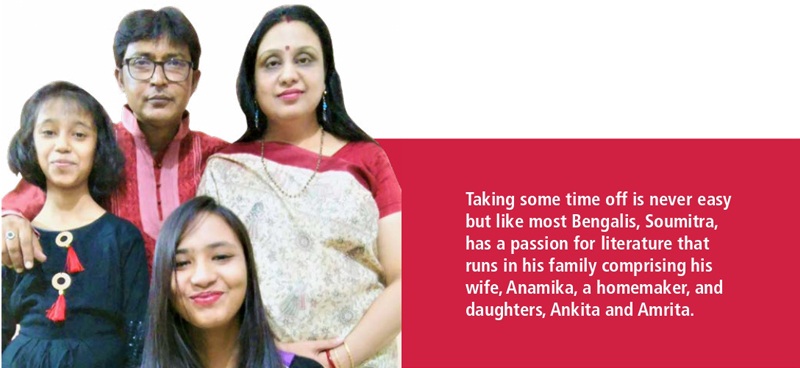
PREPARING FOR THE RAIN
Surya Kant Dubey
Assistant Manager (Mechanical), WET IC

That the farmer prepares the field before the rains to reap the rewards is traditional wisdom that Surya Kant Dubey, and team at the Narmada Kshipra LWS1 h, have leveraged. “Though we had lost nearly 3 months during the summer due to work restrictions which was perhaps the best period to execute an irrigation project, we worked out a strategy during the monsoon, the off-work work season, by liaising and building a good rapport with the farmers to establish a right of way to prepare to make up lost ground.”
“Well before the lockdown, we did our homework well by setting up production support with fabrication shops at different locations to facilitate the efficient flow of MS pipes.” Mission forward began by plotting the activity chart for pipe laying. “As the span was vast, we requested the client to help with the statutory clearances from the local administration, police department to facilitate material movement and execution, while from our side, we ensured all the safety checks,” highlights Surya. “In fact, our good work motivated the vendors to mobilize manpower through their own vehicles which set the ball rolling across work fronts.”

Executing long span pipelines is a tough task but with a range of digital applications, most of the tasks were easily driven with the system prompting follow-ups, reviews and gaps along the alignment.
Into his first project at L&T, Surya finds the digital tools handy and reliable. “Executing long span pipelines is a tough task but with a range of digital applications, most of the tasks were easily driven with the system prompting follow-ups, reviews and gaps along the alignment. Our daily meetings through MS Teams gave us the big picture and focus areas while the LMNOP app tracked the entire pipeline alignment. Almost 80% of our quality inspection is being carried out in virtual mode with the support of the Quality Incident Reporting app and safety is on track with the ViewEHS app.”
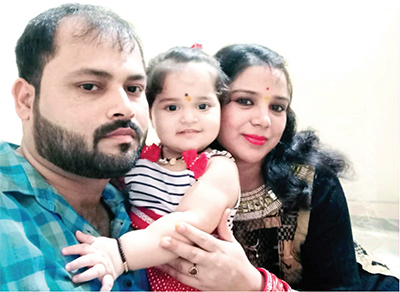
By following the rules of the game, they kept up the momentum. “Stationing a paramedical team at strategic work fronts, allocating separate working areas for the local and outstation workmen, and establishing quarantine rooms at local schools immensely boosted workmen morale and ensured their wellbeing,” mentions Surya. With the project strategically placed, there is still a long way to go for Surya, but he knows for sure that his debut with L&T has been an enterprising one which he will remember for a long time to come. “From my colleagues I have heard the joy of fulfilling vital water infrastructure projects and I would like to say this in my own way when we commission this project.”
Hailing from Raipur in Chattisgarh, Surya’s family includes his wife Sonal who is homemaker and their daughter Shambhavi. “Going together on long drives as a family is what we like,” he smiles.
NEW CHALLENGES; LOTS OF NEW LEARNING
Pragyanand Ojha
Assistant Manager (Mechanical), WET IC
Though relatively new to L&T having joined in 2019, Pragyanand Ojha, at the Narmada Kshipra Multipurpose Project, has been part of a versatile team for a year chasing the larger dream of building a vital infrastructure for farmers. “At site, the onus of delivering one of the largest irrigation projects to irrigate 30,000 hectares, meet the domestic and industrial needs across 100 villages in 5 districts of Madhya Pradesh was huge.”
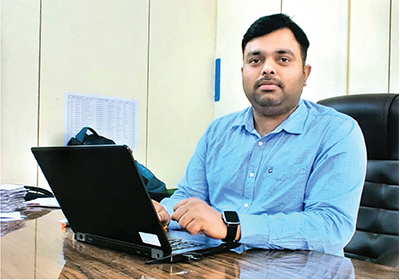
For Pragyan, as he is fondly called by his colleagues, the pandemic ushered in a whole set of challenges, many never imagined. “Workmen management was most important and, as a team, we were fairly successful in motivating and educating them about the pandemic to convince them that they were in safe hands,” he explains. “It worked for us,” he exclaims, “as close to 80% of our workmen stayed back which was the turning point as we were strategically positioned with all the work fronts activated.”

Never in my career have I had to interface so much with the local administrators and bureaucrats, but it has given me a unique insight into establishing right of way and understanding the sensitivity of work spots.
“With the need of the hour to up the ante, we implemented a month wise cost monitoring plan,” says Pragyan, “with activities prioritised in line with the milestone requirements through a task force team.” In addition, to keep things under control, the team added several resources like new agencies, mobilization of plant and machinery to fast track the works. “Never in my career have I had to interface so much with the local administrators and bureaucrats, but it has given me a unique insight into establishing right of way and understanding the sensitivity of work spots. We operated in red zones aligning to the SOPs and worked out a customized framework for each location. This was a project within a project.”
Pragyan appreciates digital tools for providing the team with both a macro vision and a micro perspective. “The convenience of 24/7 connectivity put us all on the same page to review any upfront issues and get the big picture of the project.” He commends his team for their readiness to take risks and shoulder responsibilities. “We have mobilized many vendors who had not worked with L&T before, trained and developed them to our standards and today we have a crew that has helped us achieve our milestones and book INR 73 crores of sales during the H1 quarter.” He is visibly proud of his team’s achievement.
Pragyan is thankful to his seniors, Project Director, Parthiban Mohan, and Project Planning In-charge, Manas Karmakar, for their support and guidance. “Bagging the Best Project Award in the WET IC town hall was a proud moment for us. Of course, when I share the milestone achievements with my wife Menka Bhargav and daughter Prameya, who are based in Ranchi, it is always doubly sweet.”


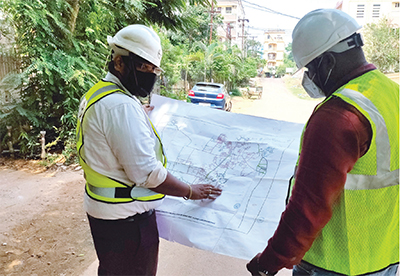
When joining as a GET in 2014, Kamal Kumar had apprehensions about how he would manage his mistakes, “but I quickly realized that training and development happen all the time across L&T’s projects with seniors guiding youngsters to make the big leap which is what has shaped me to deliver targets and move from a site engineer, planning assistant, operations coordinator to an independent planning manager,” he shares proudly from his Bhubaneswar Sewerage System project.
The Rourkela Sewerage System was a special assignment for Kamal. “I stepped in during the last leg of the project to commission the scheme, having had to rework our approach many a time depending on the emerging ground conditions and availability of resources. It was different kind of planning, something that we normally are not used to, though the need was to deliver the immediate milestones and stay on track to complete the overall deliverables.” Brainstorming helps in such situations and as he adds, “there was someone back at the site office willing to listen to my insane ideas, point out the merits and risks, motivate me to implement the schemes and get the results.”

Training and development happen all the time across L&T’s projects with seniors guiding youngsters to make the big leap which is what has shaped me to deliver targets and move from a site engineer, planning assistant, operations coordinator to an independent planning manager.
Kamal is visibly proud of their achievements. “Dusk-to-Dawn was a terrific implementation which not only propelled works but earned accolades from the client and appreciation from the locals. It helped us to work out a model scheme to finish the structural works. Another significant achievement was to complete the 804 m long 700 mm Dia Di pipelaying across the national highway within 24 hours.”
He credits success to their all-round planning. “Approvals were worked out through virtual inspections; a scattered work programme was implemented for the workmen to enhance productivity while a team that collaborated with the district officials facilitated on-field progress. The inauguration of the scheme on 16th February 2021 was a happy day for all of us,” rejoices Kamal.
Mission accomplished, Kamal has moved on to his next challenge in Bhubaneswar where the onus is to raise another state-of-theart sewerage system. Away from work, Kamal does make time to bond with his wife Komal, who is a software engineer with Infosys, to discuss on technology-based articles, share insights on innovative videos and their common affinities in music.

HONING HIS PROJECT MANAGEMENT SKILLS
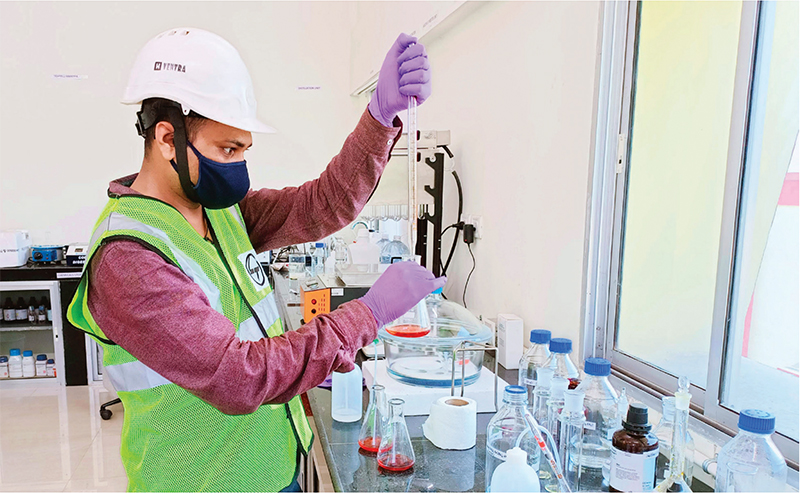
Desh Bandhu Gupta
Engineer Civil, WET IC
Ever since Desh Bandhu Gupta, Planning In-charge, Rourkela WSS, joined L&T in 2014, he has been honing his project management skills with timely innovations and value engineering. “As a DET at the Porbandar Underground Drainage Works, I had the opportunity to work with L&T’s processes, systems, and digital initiatives which has given me an edge.”

We had to rethink and recalibrate our procedures which were constantly affected by external factors. Having lost considerable time, our effort was to have specific work plans across each work front to progress securely.
While in his earlier projects, it was more about execution planning, the present scenario for Gupta calls for dynamic planning. “We had to rethink and recalibrate our procedures which were constantly affected by external factors. Having lost considerable time, our effort was to have specific work plans across each work front to progress securely with the structure and trenchless works.” As the key infrastructure was defined in a closed area, it was easy and safe for the team to address the tasks immediately while in the case of trenchless activity, the entire road was closed to facilitate execution.
Gupta smiles that delighted with their progress, the client arranged for further work permits as more fronts opened. “We had already done the hard work by plotting the safe work zones during the lockdown and hence got going immediately by taking up the execution of trunk main pipeline works and the connectivity branch sewer line. Being a major portion of the alignment, it was also helpful to raise invoices and achieve sales during these tough times.”
While on the move, monitoring was a key lever that enabled them to steer on the right track. “We had a mixed approach with hourly work location updates, review of critical stretches, daily assessment of approaching plans and resources which facilitated regular update of node wise DPR against the overall plan in E- Pragati.” Subcontractors added might to our cause, shares Gupta. “Their immediate action to mobilize workmen and align to the SOPs fast tracked operations.”
Over the last six years, there have been many proud moments at work for Gupta but the one he cherishes the most is with his parents. “The day I joined L&T, my parents blessed me and gave a 500 rupee note. I still have that note with me as a badge of inspiration and good luck.”
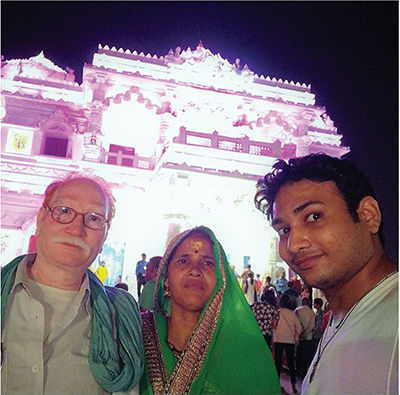
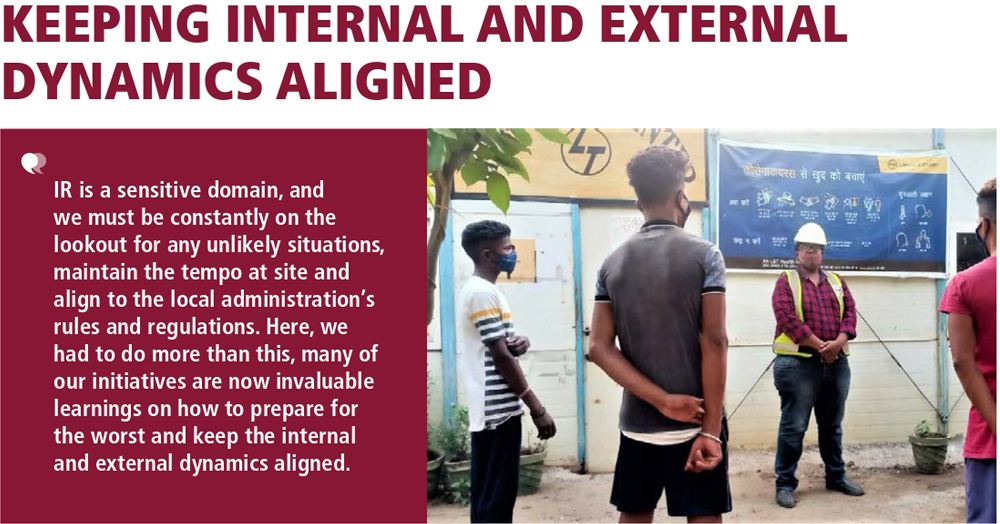
Suresh Kumar Ch
Assistant Officer (IR), WET IC
As an Industrial Relations Officer, Suresh Kumar Ch, is the first point of contact both for the workmen and the local administration to communicate key matters about implementing COVID-19 SOPs and ensure welfare at the camps. “IR is a sensitive domain, and we must be constantly on the lookout for any unlikely situations, maintain the tempo at site and align to the local administration’s rules and regulations. Here, we had to do more than this, many of our initiatives are now invaluable learnings on how to prepare for the worst and keep the internal and external dynamics aligned.”
His agenda and execution plans differed from those of his colleagues. “Our topmost priority was to orient the workmen on the do’s and don’ts to be followed at camps and work places. It is easier said than done, but we had to share the process in as detailed a manner through regular interventions.”
Having successfully driven the message, Suresh’s next target was to establish safe measures to facilitate work. “We set up separate camps for the locals and other state workmen, kept a tab on the vehicles from other states bringing resources to site with the unloading allowed only during the daytime, arranged retail outlets, formed workmen groups with a leader who was entrusted with the safety and monitoring of the group.” He is glad that all his efforts were rewarded as the team made steady progress across various fronts. “The local administration provided the necessary external support and also commended our work safety initiatives.”
For Suresh and his team, the project may have been completed but the battle continues. “There are new checklists and updates coming up from time to time which have to be aligned at work fronts and camps, communication has to be customized according to the emerging requirements, and the most important thing, is not to let our guard down.”
Suresh’s family that includes his wife Parimala and toddler daughter Bhavishya are based in his hometown at Nuzveedu in Andhra Pradesh. “I connect with them through the virtual mode and whenever at home, I do help my wife with some cooking, trying out new dishes while a daily game of chess helps to sharpen my mental acumen.”
